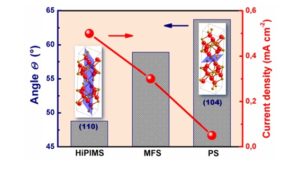Photoanodes with fully controllable texture: the enhanced water splitting efficiency of thin hematite films exhibiting solely (110) crystal orientation
 Despite of computing models suggesting that the electrical conductivity of hematite is extremely anisotropic, revealing up to four orders of magnitude higher electron transport with conduction along the (110) hematite crystal plane, synthetic approaches allowing the sole growth in that direction have not been reported yet. We have presented a new strategy for controlling the crystal orientation of very thin hematite films by adjusting energy of ion flux during advanced pulsed reactive magnetron sputtering technique. The precise control of the synthetic conditions allowed to fabricate, for the first time, hematite photoanodes exhibiting fully textured structures along (110) and (104) crystal planes with huge differences in photocurrents of 0.65 mA cm–2 and 0.02 mA cm–2 (both at 1.55 V versus RHE), respectively. The photocurrent registered for fully textured (110) film is among record values reported for thin planar films. The nanofaceting control of the 2D nanocrystaline thin films deposited is possible due to a unique plasma-assisted deposition system that has been carefully designed and installed by RCPTM research team. The depositions are carried out under so-called high power impulse magnetron sputtering (HiPIMS) and its combination with medium frequency (MF) plasma excitation. Such conditions result in increasing the deposition rate, substrate bombarding by heavy ions (the ion flux density), and the thermal flux density (if required). All these parameters can be reliably controlled owing to the required properties of the films.
Despite of computing models suggesting that the electrical conductivity of hematite is extremely anisotropic, revealing up to four orders of magnitude higher electron transport with conduction along the (110) hematite crystal plane, synthetic approaches allowing the sole growth in that direction have not been reported yet. We have presented a new strategy for controlling the crystal orientation of very thin hematite films by adjusting energy of ion flux during advanced pulsed reactive magnetron sputtering technique. The precise control of the synthetic conditions allowed to fabricate, for the first time, hematite photoanodes exhibiting fully textured structures along (110) and (104) crystal planes with huge differences in photocurrents of 0.65 mA cm–2 and 0.02 mA cm–2 (both at 1.55 V versus RHE), respectively. The photocurrent registered for fully textured (110) film is among record values reported for thin planar films. The nanofaceting control of the 2D nanocrystaline thin films deposited is possible due to a unique plasma-assisted deposition system that has been carefully designed and installed by RCPTM research team. The depositions are carried out under so-called high power impulse magnetron sputtering (HiPIMS) and its combination with medium frequency (MF) plasma excitation. Such conditions result in increasing the deposition rate, substrate bombarding by heavy ions (the ion flux density), and the thermal flux density (if required). All these parameters can be reliably controlled owing to the required properties of the films.
Kment, S.; Schmuki, P.; Zboril, R. et al. Photoanodes with fully controllable texture: the enhanced water splitting efficiency of thin hematite films exhibiting solely (110) crystal orientation, ACS Nano, 2015, 9, 7113-7123.


